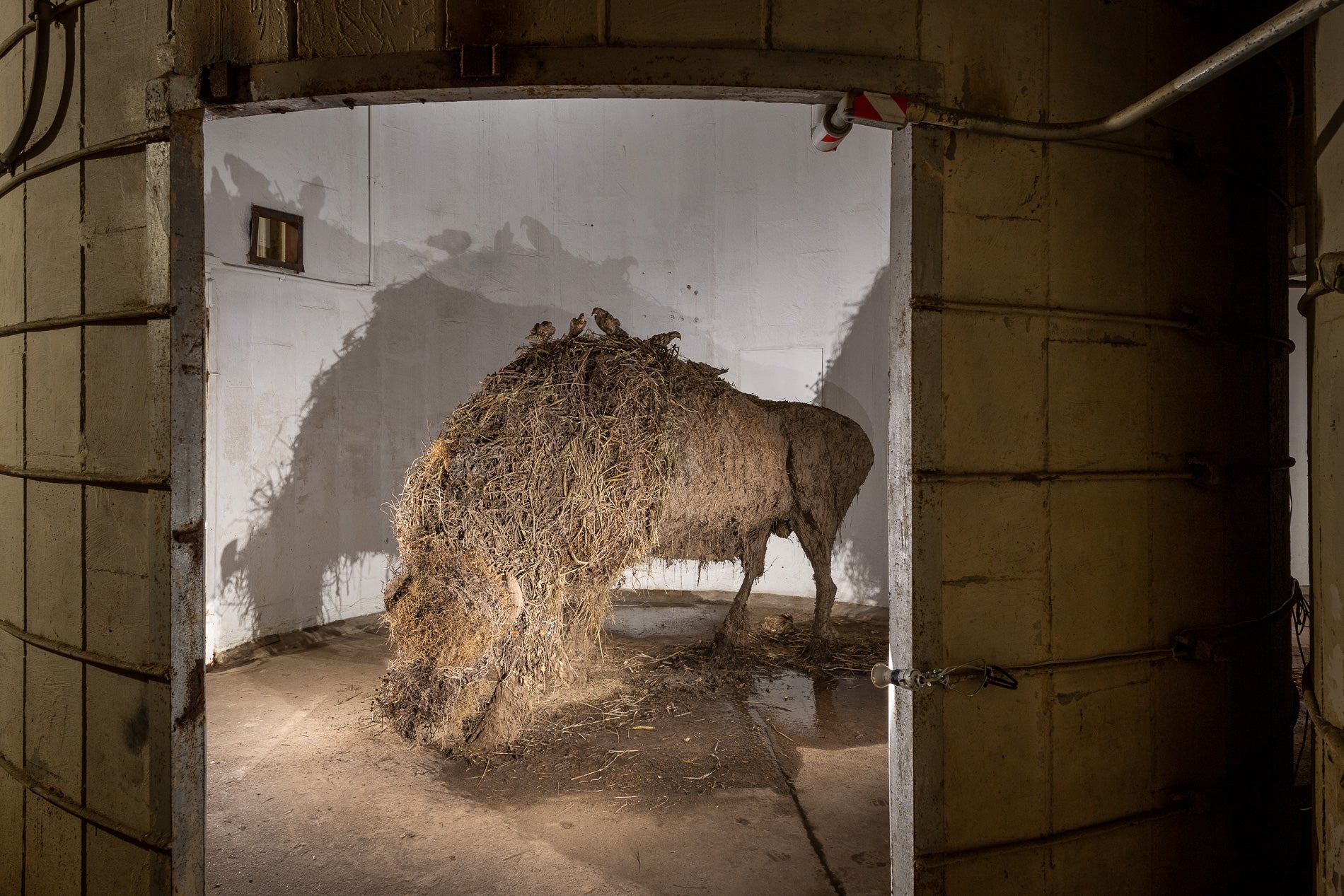
By Judith D. Schwartz
If you dig deep and keep peeling the onion, artists and freelance writers are the leaders in society—the people who start to get new ideas out. This quote by Allan Savory, the wildlife biologist from Zimbabwe who developed Holistic Management, keeps Houston-based artist Cindee Klement motivated and trains her vision on regeneration: on illuminating the world she would like to see. Cindee is not merely inspired by nature’s regenerative processes: she brings them into her work, depicting the dynamism of plants, soil, and insects and conveying what’s possible. I encountered Cindee’s work through her son and daughter-in-law, Griffin and Alex Groome Klement [Note: Alex, now with nRhythm, was featured in the Unconventional Paths podcast]. (Specifically, while on a Zoom with Alex, I noticed Cindee’s drawing of a cow in the background!) Her work appears in many collections, and Houston’s mayor declared last August 24 “Cindee Klement Day” to honor her contribution to the city. I recently talked with Cindee about her pathway to art and activism, how to tell a soil story, and the regenerative potential of urban landscapes.

JDS: You’ve only regarded yourself a visual artist within the last decade. Can you describe an early piece that’s significant to you?
Cindee: My first sculpture was a bronze hat. I grew up very isolated on a cotton farm in Dell City, Texas, south of where history defines the Dustbowl. My mother told me that my parents once came home to two feet of dirt blown into the house. Also that an old rancher said he remembered when that part of the country was covered in grasses as high as a horse’s belly. My grandfather always had a Stetson Open Road silverbelly hat. Out there nothing stops the wind. If it blew off it was never coming back. In 2017 I visited our old farm and saw the toll of eighty years of erosion on the landscape. This was man-made, not “natural” as I had thought. Recognizing that was an “aha” moment for me.

I’ve casted six hats, corresponding to the six tenets of regenerative agriculture: eliminating tillage; maximizing biodiversity; keeping soil covered; maintaining living roots year-round; integrating livestock; managing holistically. I call the project “Gust”, to note how everything can go up in a gust of wind. However, in art and life, I try to turn problems into solutions. The memory of a hat caught in a gust and watching it tumble across the desert is depressing but also visually beautiful: I was captivated by the shapes as the hat twisted in the wind, slammed against the ground, and then was sucked back into the sky until it disappeared into the beige nothingness. This image of desertification, symbolized by tumbling hats, needn’t be the end of the story. Humans have the ability and knowledge to change the narrative and reverse the ecological path we’re on.
JDS: Hurricane Harvey was devastating to Houston. How did this affect your work?
Cindee: I was lucky. The water came halfway up our yard but the street didn’t flood, likely because a huge watermain was replaced a few years back. For one or two years I worked on monoprints of “Harvey heroes”, visual stories of people taking care of others, driving trucks through the water to pull people out: racial, political, gender, religious tensions were washed away. That was the silver lining of Hurricane Harvey, what raised our Texas spirit above the flood line, a story that needs to be told and told and told. I was using a technique that evokes water, thinking about water all the time, and I listened again to one of Allan Savory’s talks: he said something about a characteristic of deserts, how water runs across the land and doesn’t soak in. Coming from a farm near El Paso, I knew what that looked like. I thought, wow—Houston is a coastal prairie, but it acts like the desert. We’re living in place that should be soaking up mega amounts of rainwater. I started imagining what this landscape could be.

JDS: You’ve recently focused on insects, which are basic to the food chain and yet are under stress. How did this come about?
Cindee: In 2017 the first bee, the Rusty Patched Bumble Bee, went on the Endangered Species List. I was struck by the fact that this creature, the bee, is so crucial to our existence that we use it to talk about fertility and even sexuality—“the birds and the bees”—and we don’t know the first thing about it. I became hyperfocused on studying bees and how they are harmed by pesticides. I binge-watched bee movies one 4th of July. My children bought me a “Bee School” for my birthday. For the series I mix water and ink with something that repels water, which highlights individual particles and creates a synergistic, “buzzy” effect. I decided to call it “Rumblings”, one of nature’s ways to alert living creatures to their environment, to make us aware of what we’re losing.

JDS: At some point you became enamored of soil, and the role of native bison in creating healthy soil. Tell us about The Soul of Humus.
This is a sculpture of a male bison, intended to be exhibited in a grain silo, itself a relic of industrial agriculture. In the hide of the sculpture is the narrative of soil health. The armature is made from welded steel, covered in stainless-steel lath. The next layer is native clay soil and the coat is locally-sourced grasses and sedges, seeds and pods. While working on it I got a puncture wound that required three surgical cleanings. Griffin came to my aid and in one day we added 800 pounds of indigenous soil.
The bison is 112 inches long, with its head down as if to graze. Bison once numbered 30 million across our prairies, sustaining topsoil and stimulating photosynthesis: massive roving composters, harnessing carbon from the air and returning it as sugars to feed the dynamic root microbiomes below the earth’s skin. Bird and butterfly habitat were abundant when the bison roamed. I wanted to tell the story of the relationship between grazing herds, the living soil, and ways to reimagine urban and agricultural landscapes.

JDS: Far from the hanging-on-a-museum-wall kind of art, yours is anything but static. What is your “living art” project in downtown Houston?
Cindee: I’ve long been interested in how art can incorporate time and movement. With “Symbiosis”, at the Lawndale Art Center, I’m stretching my practice by reimagining urban landscaping in a way that restores an ecological balance. The Center invited me to install an environmental sculpture in their sculpture garden. The typical manicured garden requires weed-killing chemicals and gas-powered mowers. This multi-year project values all living creatures as participants in the creative process. It is designed to build the food chain, not destroy it. It is a lot of hard work, but amazing to see things come back so quickly. When I began last year I dug up one cubic foot of soil, spread it out, and saw not one bug. I did the first plantings in April and then in October I saw a tree frog. It went from completely sterile soil to supporting amphibians in less than a year. I had never seen a tree frog in Houston before. Tree frog eggs look like beautiful underwater pearls.
JDS: Many assume regenerative solutions only take place on farms, ranches and natural areas. What opportunities do you see in a city like Houston?
Cindee: Houston is important ecologically in many ways. First, the landscape. Our growing season is 12 months a year. It’s never dormant: something is always blooming. Also, we’re in the middle of two migratory pathways for birds. The city is 600-square miles of what was once coastal prairie, a highly diverse ecosystem of which less than one percent remains. In my art I focus on what was here and what could be here if we choose to make it so. Then there’s the cultural side. Houston has a mix of people from all over the world and creative blends of cuisine. We have a thriving music industry and the largest conglomeration of art studios in one place. If good thing happen here the story can spread to many places.
I have read that our cities are fast-forwarding evolution. If this is true, integrating holistic, regenerative biological systems into urban landscapes will fast-forward ecological recovery. Right now every school, restaurant, and business spends something like $4 to $10 per square foot on annual landscaping that doesn’t do anything for the environment. Think of the money and the water savings if we used perennials—particularly native plants that evolved to withstand droughts and floods. In a city, if we change our landscaping we can change the environment. With the Lawndale project, the Center’s leadership said to “propose the dream”. I saw the chance to show what a native landscape would look like at the scale of someone’s yard. The same way that I flipped the narrative of the hats, as a society we can flip the narrative of industrialization and start to “industrialize” ecological recovery in our cities.
Nikki Lindt:
Nikki's current project, Underground Sound explores the sounds of nature—including that of soil. She's currently headed to the Arctic to record permafrost thaw.
Zoë Bestel:
Zoë is a young singer / songwriter in Scotland whose music is inspired by regeneration! She does a weekly Wednesday live stream at 7:00 pm (British Summer Time).
---
Judith D. Schwartz is the author of three books on regeneration —The Reindeer Chronicles, Cows Save the Planet, and Water in Plain Sight — each of which has advanced the regenerative movement. She is a founding member of Soil Centric’s Advisory Board.
Soil Centric was founded on the premise that everyone has a role to play in solving the climate crisis. By aggregating and curating opportunities, resources and examples of regeneration taking place around the world, we’re here to help you find your role! Our web-based app can help guide you on your regenerative journey.
